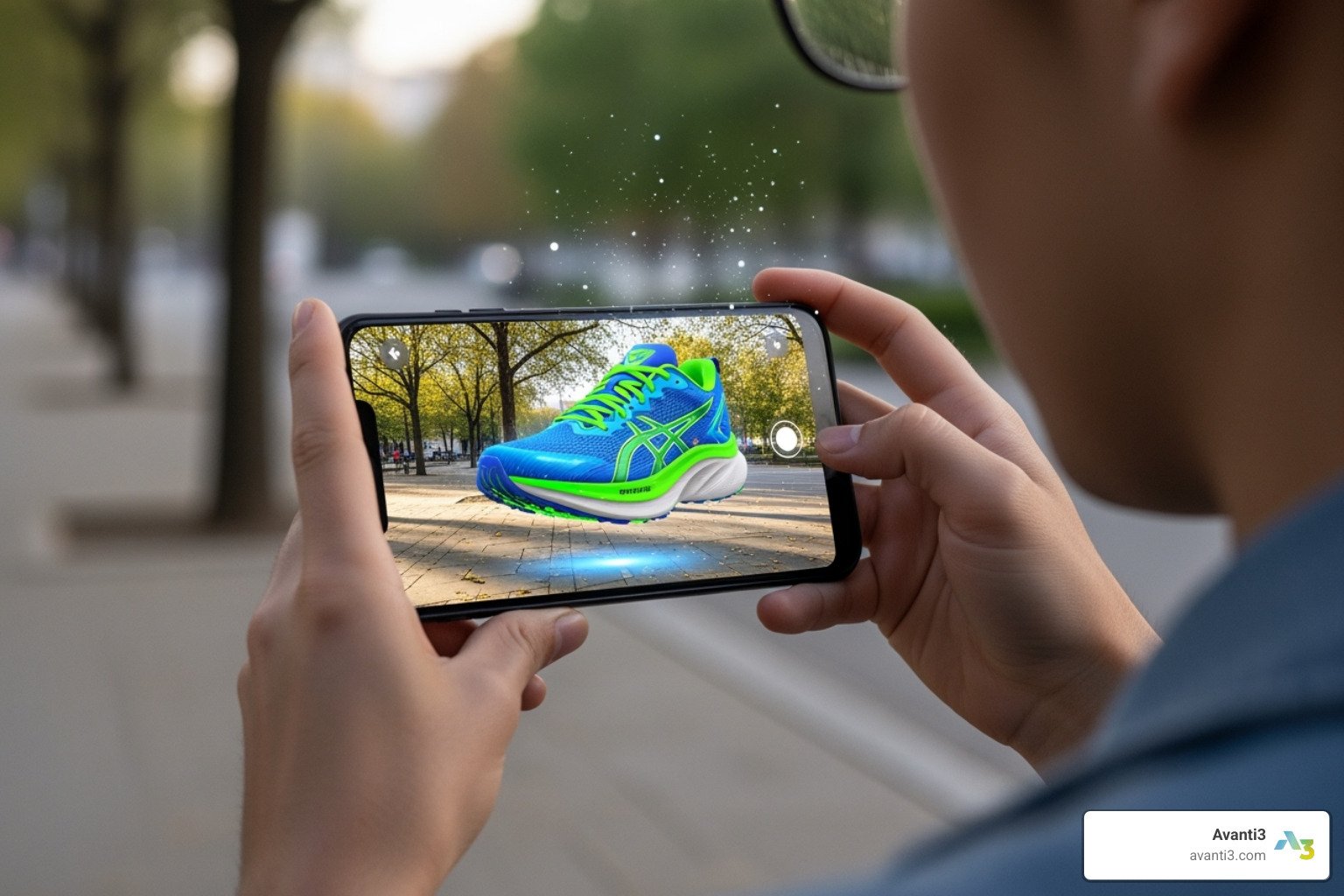Augmented reality engagement: 7 Powerful Ways to Skyrocket Success 2025
The Engagement Revolution: How AR is Changing Customer Interactions
Augmented reality engagement refers to the use of AR technology to create interactive, immersive experiences that connect brands with customers. Here’s what you need to know:
- Definition: AR overlays digital content onto the real world through smartphones or other devices
- Impact: AR experiences are 200% more engaging than non-AR equivalents
- Adoption: 61% of consumers prefer retailers with AR experiences
- Conversion: Brands using AR see up to 94% increase in sales conversions
- Retention: 64% of consumers say AR use increases their brand loyalty
- Reach: By the end of 2024, there will be an estimated 1.73 billion AR user devices worldwide
The numbers don’t lie – AR is revolutionizing how brands connect with their audiences. Whether it’s trying on products virtually before purchase, bringing packaging to life with interactive stories, or providing immersive self-service support, AR creates memorable moments that traditional marketing simply can’t match.
What makes AR so powerful? It transforms passive viewers into active participants. Instead of just seeing your product or message, customers can interact with it in their own environment, creating a personal connection that drives deeper engagement and stronger emotional bonds.
I’m Samir ElKamouny AV, an entrepreneur and marketing expert who has helped countless businesses implement augmented reality engagement strategies that drive measurable results and create lasting customer connections. Let me guide you through the exciting possibilities AR offers for your brand.
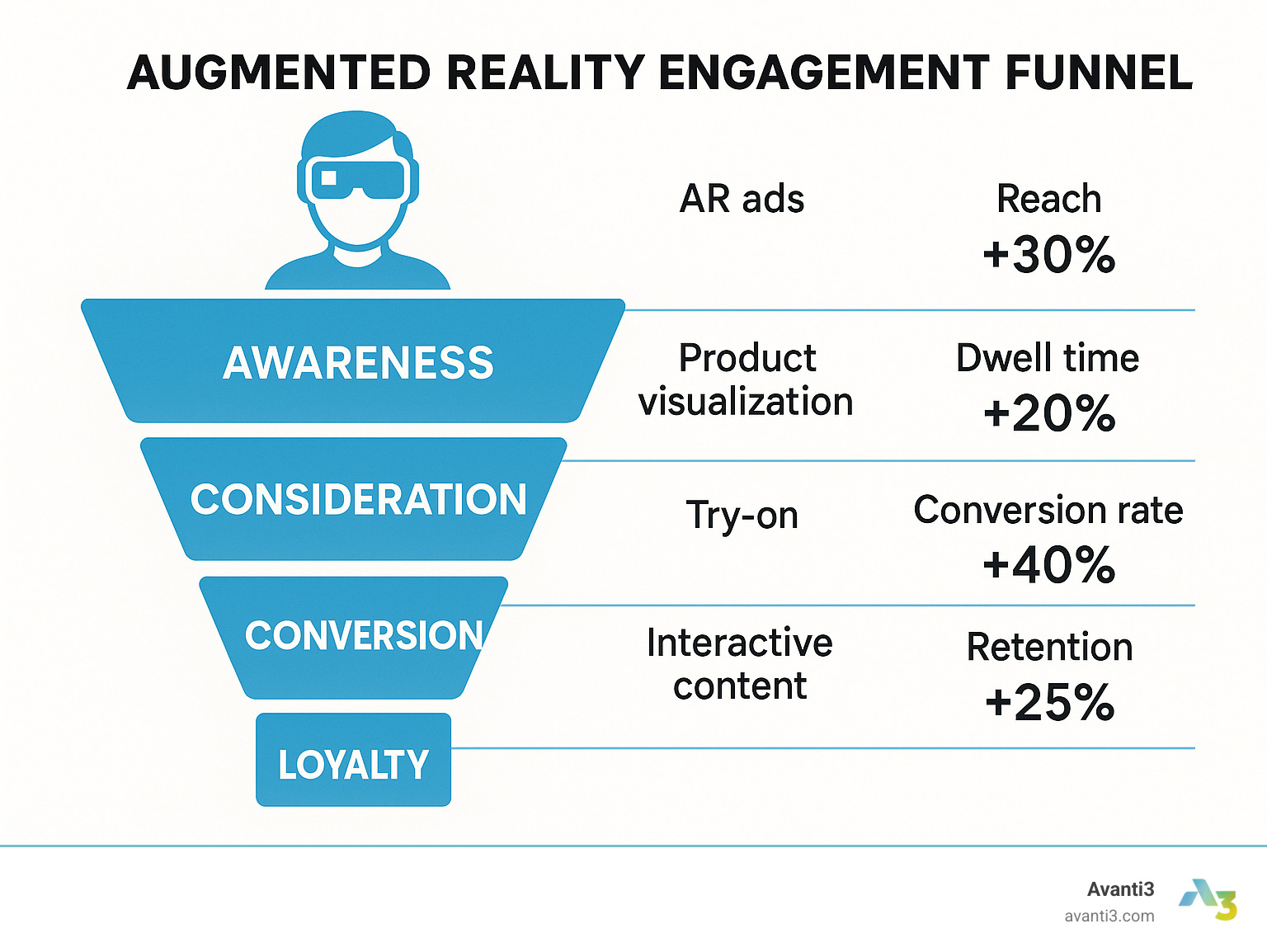
Understanding Augmented Reality Engagement Across the Customer Journey
When we talk about augmented reality engagement, we’re not just discussing a flashy tech trend—we’re exploring a tool that transforms every touchpoint with your customers. Unlike virtual reality that creates entirely digital worlds, AR improves the real world by blending digital elements with what we can already see, using the cameras and sensors in devices your customers already own.
As technology pioneer Ben Houston puts it: “AR is going to become ubiquitous to the point of becoming an integrated expectation of the buying experience. Brands that want to connect with customers today and tomorrow need to move now on AR.”
What makes AR so accessible is its convenience. Thanks to WebAR technology, users don’t even need to download special apps—experiences launch right in their browsers. This mobile-first approach meets people exactly where they already spend hours each day: on their smartphones.
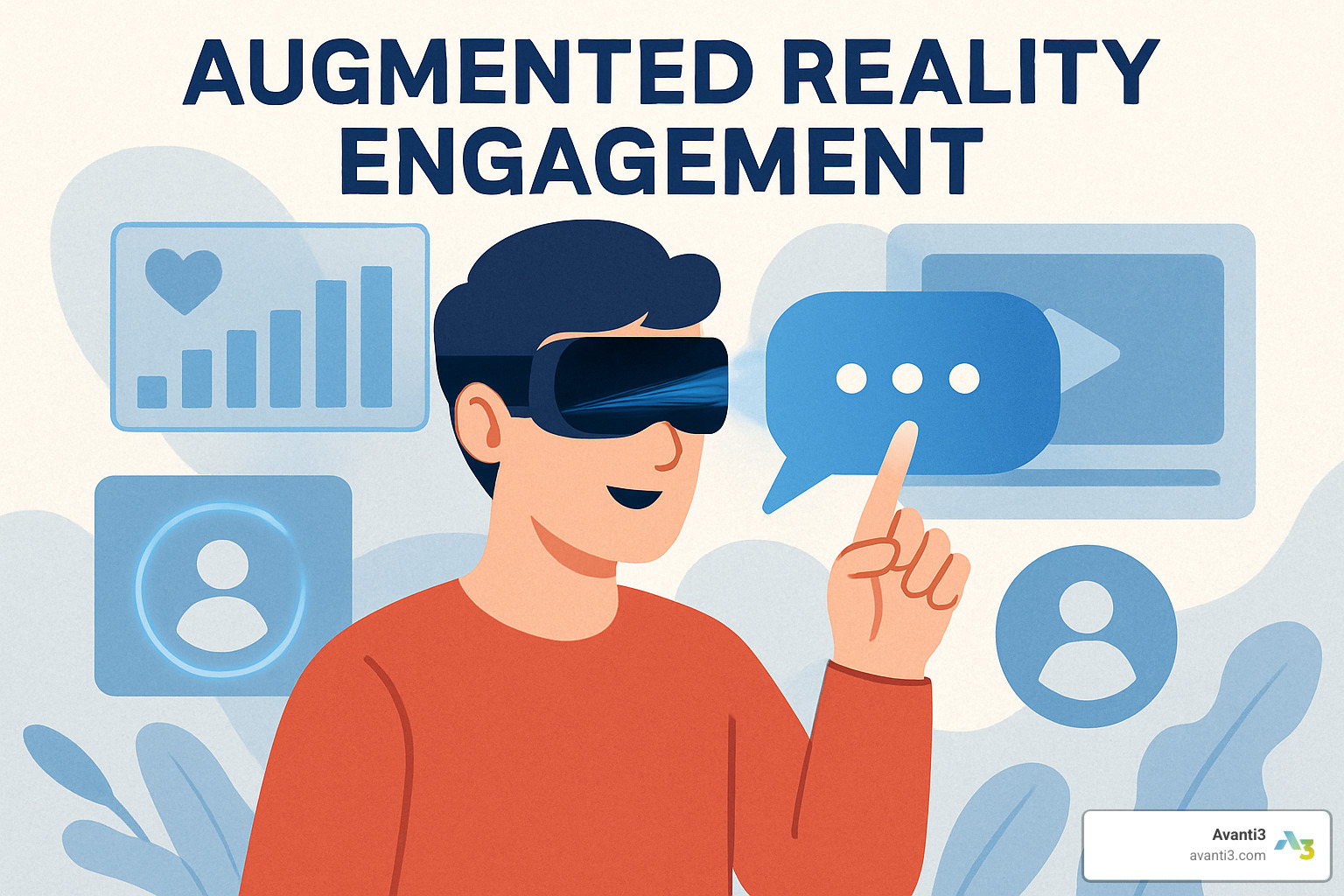
Let’s walk through how augmented reality engagement improves each stage of your customer’s journey:
Augmented Reality Engagement in the Pre-Sale Phase
During pre-sale, customers are finding and researching products. Here’s where AR becomes your secret weapon for capturing attention:
Virtual Try-On Experiences create those “wow” moments that hook potential customers. Dior’s AR Beauty Try-On campaign reached 4 million people with a stunning 41% interaction rate and 400,000 virtual try-ons. People love seeing how products look on them before committing.
Product Visualization solves the “will it fit my space?” dilemma. IKEA’s Place app uses LiDAR technology to measure rooms and position true-to-scale furniture models in your actual living room. Suddenly, that new sofa isn’t just a product image—it’s sitting right where you might place it.
Industry research confirms what early adopters are seeing: AR product experiences are 200% more engaging because they deliver double the interactivity compared to traditional product displays.
Gamified Findy turns shopping into play. Vodafone’s “Elf and Seek” AR game attracted 245,000 players who captured 270,000 virtual elves and claimed 20,000 prizes. This transformed routine product browsing into a memorable trip that people actually wanted to participate in.
Location-Based Filters bring the digital and physical worlds together. These geofenced AR experiences drive foot traffic to physical stores while creating Instagram-worthy moments that customers love to share, extending your brand reach organically.
Augmented Reality Engagement at Point of Purchase
When customers are on the fence about buying, AR helps them take that final step with confidence:
In-App Checkout Integration removes friction from the buying process. After virtually trying on sunglasses or makeup, customers can purchase their preferred items without leaving the AR experience—maintaining that emotional connection all the way through checkout.
AR Mirrors in Retail create showstopping experiences. Maybelline’s “world’s largest AR mirror” on a shopping mall facade let passersby try mascara virtually. This single-day activation generated 3 million organic views and significantly boosted foot traffic to their store.
Conversion Boosts speak for themselves in the data. Brands offering AR experiences see up to 40% higher conversion rates compared to those who don’t. Why? AR reduces purchase uncertainty by letting customers visualize products in context—in their homes, on their bodies, or in their lives.
Reduced Returns save money and frustration for everyone. When customers can accurately visualize products before purchase, return rates drop dramatically. This is especially valuable for furniture, clothing, and cosmetics, where fit and appearance make or break satisfaction.
Augmented Reality Engagement for Post-Sale Support
The relationship doesn’t end at purchase. AR continues driving engagement and loyalty afterward:
AR Manuals and Guides make complex products simple to use. Automotive brands have pioneered AR owner’s manuals that overlay maintenance instructions directly on vehicle components. Suddenly, finding that hidden oil cap isn’t a frustrating treasure hunt.
Self-Service Support empowers customers to solve problems independently. By scanning a product with their smartphone, customers receive visual guides that walk them through troubleshooting—reducing support calls while increasing satisfaction.
Retention Through Continued Value keeps products fresh and exciting. AR packaging can open up exclusive content, games, or experiences that customers enjoy long after purchase. This extends the product experience and strengthens their connection to your brand.
Upsell Opportunities arise naturally when AR identifies complementary products based on what customers already own. A furniture AR app might suggest matching accessories when someone scans their existing sofa—helpful for them, profitable for you.
By thoughtfully implementing augmented reality engagement across your entire customer journey, you create a cohesive experience that not only drives initial purchases but fosters the kind of long-term loyalty that turns customers into advocates.
Ready to transform your customer experience with AR? Learn more about Digital Engagement Solutions that can take your brand to the next level.
The Business Impact: Benefits, ROI & Data Insights
The business case for augmented reality engagement is compelling. When implemented strategically, AR delivers measurable returns across multiple key performance indicators:
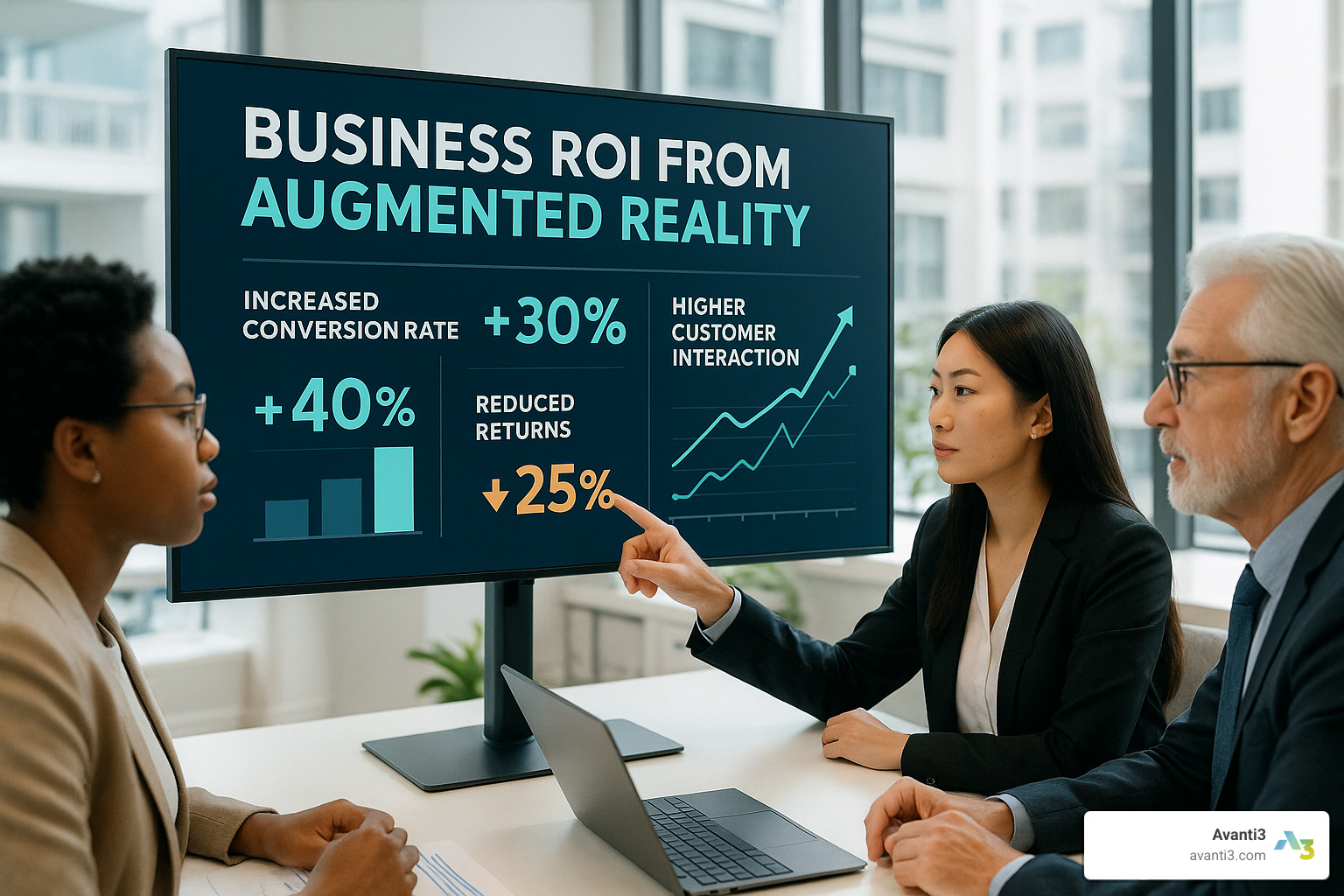
When I talk with brands about AR, they’re often surprised to learn that AR experiences don’t just feel cooler than traditional marketing—they actually drive remarkable business results. We’re seeing conversion increases of up to 94% when AR is part of the purchase journey. Customers spend twice as long engaging with AR content compared to standard digital media. And perhaps most impressively, AR experiences get shared 40% more often than traditional content, creating a ripple effect of organic reach.
These aren’t just vanity metrics. They translate directly to customer loyalty, with 64% of consumers reporting stronger brand attachment after meaningful AR interactions. The data tells a clear story: AR isn’t just a shiny new toy—it’s a serious business tool with measurable ROI.
Why Brands See 200% More Interaction
The dramatic increase in engagement isn’t just about novelty—it’s rooted in how AR affects our brains and behavior:
Emotional immersion is the secret sauce here. When you see a couch in a catalog, that’s nice. When you see that same couch sitting in your actual living room through AR, something magical happens. You form an emotional connection. You can almost feel the texture, imagine yourself lounging on it after a long day. This sense of presence and ownership simply can’t be matched by static images.
I once watched a customer literally gasp when she saw how a painting would look on her wall through an AR app. That’s the kind of visceral reaction that drives purchasing decisions.
Neurological engagement takes this even further. Our brains light up differently when we interact rather than just observe. AR activates multiple brain regions simultaneously, creating stronger memory imprints and deeper brand associations. Think about how much more you remember from activities you participated in versus things you merely watched.
Social virality happens naturally with compelling AR experiences. People love showing off cool AR filters, virtual try-ons, and interactive packaging. When a customer shares their virtual makeover or shows friends how they look in those digital sunglasses, they’re extending your brand reach without you spending an extra penny on advertising. That’s why AR content gets shared 40% more than standard posts.
Repeat usage is where the long-term value really shines. Well-crafted AR experiences keep customers coming back. Whether it’s through gamification elements, regularly refreshed content, or personalized recommendations, brands can transform one-time AR users into repeat visitors who develop deeper connections over time.
Measuring Success & Calculating ROI of Augmented Reality Engagement
Getting executive buy-in for AR initiatives requires speaking the language of metrics and ROI. Here’s how smart brands are measuring AR success:
Traditional engagement metrics tell part of the story—AR typically delivers click-through rates that outperform industry standards, dwell times that often double what you’d see with non-AR content, and impressively high completion rates for interactive experiences.
But where things get really interesting is in conversion metrics. We’re seeing conversion rate lifts of up to 94% when AR is integrated thoughtfully into the purchase journey. Average order values tend to increase too, as do basket sizes. Customers who use AR before buying are also significantly less likely to return products, creating additional operational savings.
Take Circle K’s partnership with Pokémon Go as an example. Their rewarded AR experiences achieved 76% engagement rates and 95% completion rates—numbers that would make any digital marketer’s jaw drop. But the real win? These engaging AR moments drove measurable foot traffic to physical stores, connecting digital engagement to real-world sales.
The data collection capabilities of AR also provide invaluable customer insights. By analyzing how users interact with AR experiences—which products they view longest, which features they engage with most—brands gain unprecedented visibility into customer preferences. These insights can inform everything from product development to merchandising strategies.
For businesses looking to build a comprehensive approach to customer engagement, more information about Digital Engagement Solutions can help you understand how AR fits into your broader strategy.
The table has turned. AR is no longer just an experimental nice-to-have—it’s becoming a competitive necessity with clear, measurable returns. The brands that understand this shift are already reaping the rewards of deeper customer connections and stronger business results.
Standout Successes: Real-World AR Engagement Campaigns
Nothing tells the story of augmented reality engagement quite like seeing it in action. Let’s explore some of the most creative and effective AR campaigns that have captivated audiences and delivered impressive results for brands:
Pepsi’s Unbelievable Bus Shelter
Imagine waiting for your bus on a typical London morning when suddenly a tiger appears to prowl down the street, or a UFO seems to hover right above the buildings. Pepsi turned this imagination into reality with their ingenious AR bus shelter. By changing an ordinary shelter into a window to the extraordinary, they created not just an ad but a memorable experience that commuters couldn’t wait to share. The campaign spread like wildfire across social media, proving that AR can turn even the most mundane moments into shareable excitement.
“AR’s true power lies in its ability to create memorable moments that break through the noise of traditional advertising.” – Marketing expert
Gucci Bloom AR Experience
Fragrance marketing typically relies on beautiful imagery and celebrity endorsements, but how do you convey scent digitally? Gucci found the answer with their enchanting AR portal game for Gucci Bloom. Users were transported into a virtual garden maze where they could explore the fragrance’s inspirations and ingredients through an immersive journey. The magic of this approach showed in the numbers—users spent over three minutes engaging with the experience on average, which is practically an eternity in today’s fast-scrolling digital world.
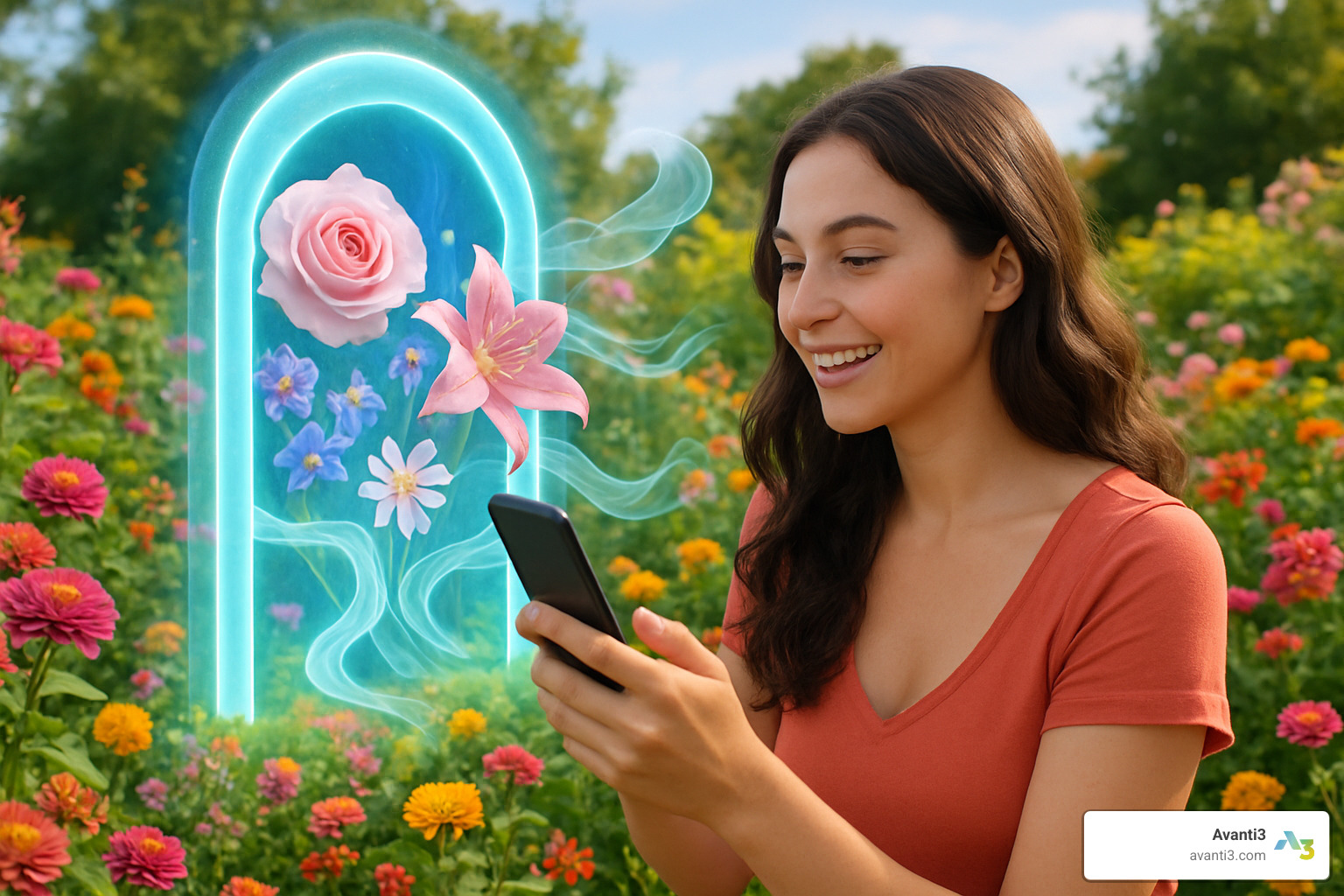
IKEA Place App
The “will it fit?” question has plagued furniture shoppers forever. IKEA’s Place app answered this question beautifully by letting customers see true-to-scale furniture in their actual homes before purchasing. With over 2 million downloads, this practical application of AR has transformed the furniture buying experience. The most telling statistic? Customers who use the AR features are 11 times more likely to make a purchase, and return rates have dropped significantly. This isn’t just engaging marketing—it’s solving a real customer problem.
Mini AR Advertising Campaign
Mini brought the showroom experience right to potential customers’ living rooms with their AR campaign. Users could place a virtual Mini in their driveway, change its color with a tap, add accessories, and even take it for a virtual spin—all without leaving home. This interactive approach outperformed traditional video ads by achieving 25% higher engagement rates, showing how AR can transform passive viewers into active participants in the brand experience.
Maybelline’s Giant AR Mirror
Maybelline took AR to a spectacular scale by creating what they dubbed “the world’s largest AR mirror” on a shopping mall facade. Passersby could instantly see themselves wearing different mascara products without a speck of actual makeup. This innovative installation generated 3 million organic views in just one day and significantly boosted foot traffic to Maybelline counters inside the mall. It was a perfect blend of digital wow-factor and practical retail results.
Toyota Crown AR Experience
When showroom visits became challenging during recent years, Toyota created an AR solution that brought their Crown model directly to potential customers. Users could place a true-scale virtual car in their driveway, peek inside to explore interior features, and customize options in real-time. This approach kept Toyota connected with car shoppers during difficult times and demonstrated how augmented reality engagement can bridge physical limitations.
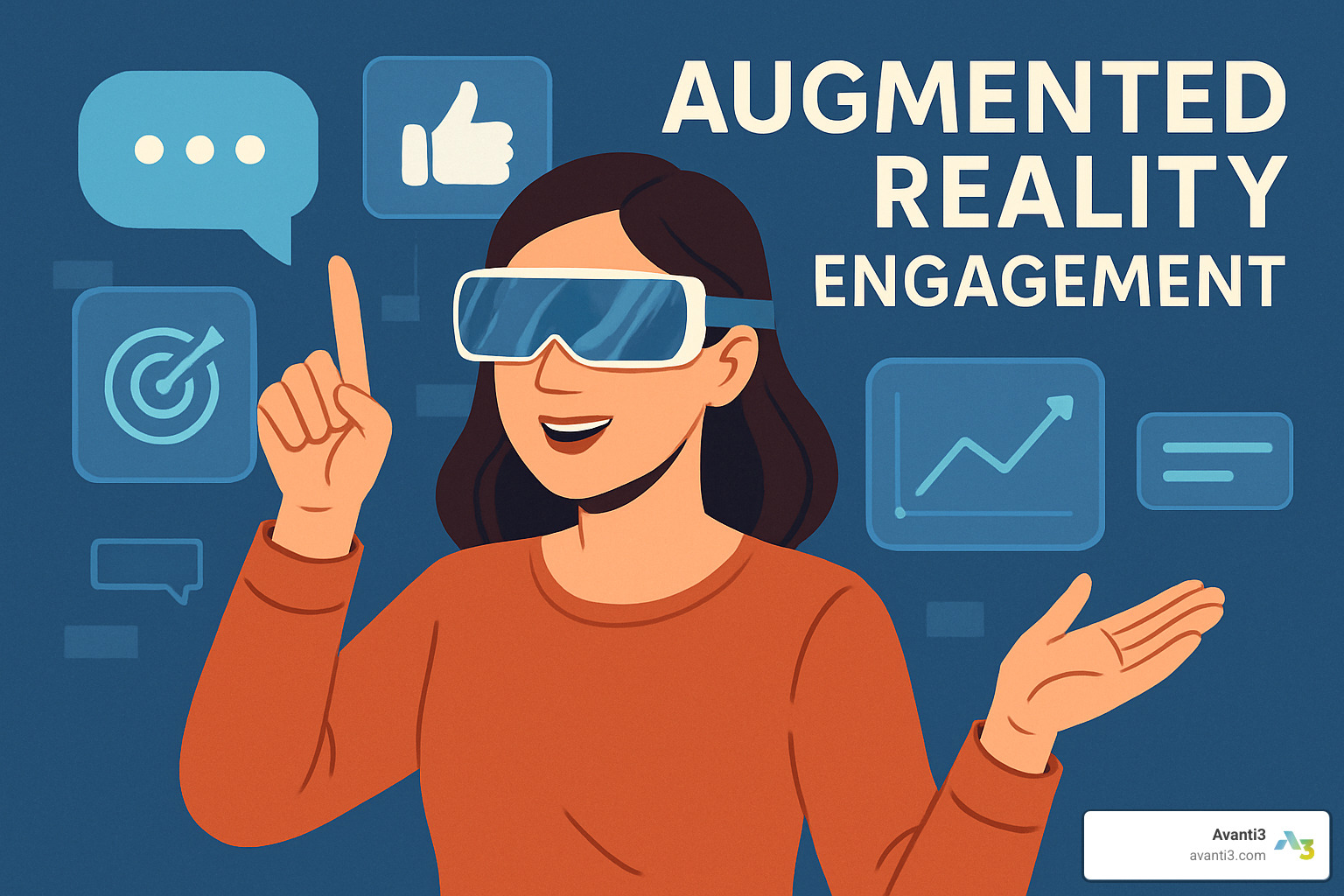
Vodafone’s “Elf and Seek” AR Game
Vodafone transformed holiday shopping from a chore into an trip with their “Elf and Seek” AR game. Shoppers hunted for virtual elves hidden throughout stores and streets, capturing them for rewards and exclusive offers. The playful approach resonated with customers—245,000 players enthusiastically captured 270,000 virtual elves and claimed 20,000 prizes. Most importantly for Vodafone, the game drove significant foot traffic during the competitive holiday season, proving that fun and business results can go hand in hand.
These examples show the versatility of augmented reality engagement across different industries and goals. For those interested in how AR is changing transportation experiences, AR experiences are revolutionizing everything from showroom visits to the driving experience itself. And if you’re looking for creative inspiration for public AR installations, Pepsi’s AR bus shelter offers a masterclass in creating memorable public AR moments.
What makes these campaigns successful isn’t just the technology—it’s how they use AR to create meaningful connections that serve both the customer and the brand. The best AR experiences don’t feel like marketing at all; they feel like magic, utility, or play that happens to feature a brand at the center.
Crafting & Scaling Immersive AR Experiences: Strategy, Tools, Best Practices
Creating memorable augmented reality engagement experiences isn’t just about having cool technology—it’s about thoughtfully designing experiences that delight users while meeting your business goals. Let’s walk through how to build AR experiences that truly connect with your audience.
Design Thinking for AR Experiences
The most successful AR campaigns begin with putting your customers at the center of everything. Before jumping into technical details, ask yourself: What problem are you solving for your users? What moment of delight can you create?
Start by defining clear objectives for your AR campaign. Are you looking to boost product consideration? Increase conversion rates? Or perhaps improve customer support? Your goals will shape every aspect of your design.
Understanding where and how people will use your AR experience is equally important. Someone browsing products at home has different needs than someone standing in a busy store aisle. Context matters enormously in AR design.

I’ve found storyboarding to be incredibly helpful when planning AR experiences. Sketch out the complete user journey—from how they’ll find your AR experience (QR code? Package scan? Social media?) through each step of interaction. This visual roadmap helps identify potential friction points before development begins.
Remember what one AR implementation expert told me: “It’s not enough to implement AR technology; the app must run smoothly and bug-free.” Users have little patience for clunky experiences, so simplicity and intuitive design are non-negotiable.
Technical Implementation Considerations
Once you’ve mapped out your user experience, it’s time to choose the right technical approach. You have several options, each with different tradeoffs:
Social AR platforms like Snapchat, Instagram, and TikTok offer built-in audiences but less customization. WebAR experiences run directly in browsers without app downloads, removing a huge adoption barrier. Native AR apps provide the deepest functionality but require users to download something new. Development frameworks like ARKit (iOS) and ARCore (Android) give you the most control but require specialized development skills.
The 3D assets you create are the stars of your AR show. High-quality, optimized models make the difference between an experience that feels magical versus one that feels fake. Consider using photogrammetry to capture real objects with incredible detail, or work with 3D artists to create custom assets that perfectly match your vision.
Always, always test your experiences across different devices, lighting conditions, and environments. What works perfectly in your controlled office setting might fall apart in a dimly lit living room or on an older smartphone model.
Personalization That Converts: Using Data to Tailor Augmented Reality Engagement
The most powerful AR experiences feel like they were made just for you. Personalization isn’t just a nice-to-have—it dramatically increases conversion rates and engagement time.
Behavioral triggers can transform a generic AR experience into something remarkably relevant. When a furniture retailer shows different AR product recommendations based on whether you’ve been browsing modern or traditional styles, that relevance creates an immediate connection.
AI-powered recommendations take this even further, dynamically adjusting what users see based on their unique preferences and past interactions. And with dynamic content that updates based on location, weather, time of day, or current inventory, you can create AR experiences that always feel fresh and contextual.
I love the example of a cosmetics brand that adjusts its AR makeup try-on options based on previous purchases, detected skin tone, and seasonal trends. This level of thoughtful personalization creates moments where customers think, “Wow, they really get me”—and that’s when conversion magic happens.
Overcoming Technical & Operational Challenges
Let’s be honest: implementing augmented reality engagement isn’t without its challenges. Device fragmentation means your beautiful experience might look entirely different across various phones. The solution? Design for the lowest common denominator while adding progressive improvements for more capable devices.
Bandwidth limitations can turn a smooth experience into a frustrating wait. Smart developers optimize 3D assets ruthlessly and implement progressive loading so users see something engaging while heavier elements load in the background.
Privacy concerns are very real in AR, which often uses cameras and location data. Be transparent about what you’re collecting and why. Only gather data that directly improves the user experience, and make sure you’re compliant with regulations like GDPR.
Many companies struggle with their content pipeline—creating, approving, and updating AR content efficiently. Establishing clear workflows and approval processes early saves enormous headaches later.
And finally, the talent gap: AR development requires specialized skills that many organizations don’t have in-house. Consider partnering with experienced AR developers or exploring no-code/low-code AR platforms that make creation more accessible.
Launch Roadmap for Businesses of Any Size
The beauty of augmented reality engagement is that it can be scaled to fit businesses of any size and budget. You don’t need a massive team or budget to create meaningful AR experiences.
Small businesses can start with pre-built AR templates on social platforms or use WebAR to avoid app development costs. Focus on a single high-impact use case rather than trying to do everything at once. QR codes are your friends—they’re an inexpensive way to bridge physical products to digital AR experiences.
Mid-sized companies can develop custom AR experiences for key products and integrate them with existing e-commerce platforms. This is also the stage to implement basic personalization features and build a simple AR content management system. Don’t forget to train your staff to support these new AR initiatives—they need to understand the value to convey it to customers.
Enterprises can create comprehensive AR strategies that span the entire customer journey. Integration with CRM and marketing automation systems allows for sophisticated personalization and analytics. At this scale, establishing a dedicated AR center of excellence helps maintain quality and drive innovation.
As Apple CEO Tim Cook noted: “I do think that a significant portion of the population of developed countries, and eventually all countries, will have AR experiences every day, almost like eating three meals a day. It will become that much a part of you.”
The key is starting small, gathering real feedback, measuring results, and scaling based on what works. For businesses looking to transform their marketing through immersive technologies, AR Marketing Solutions provide a framework to guide your implementation journey.
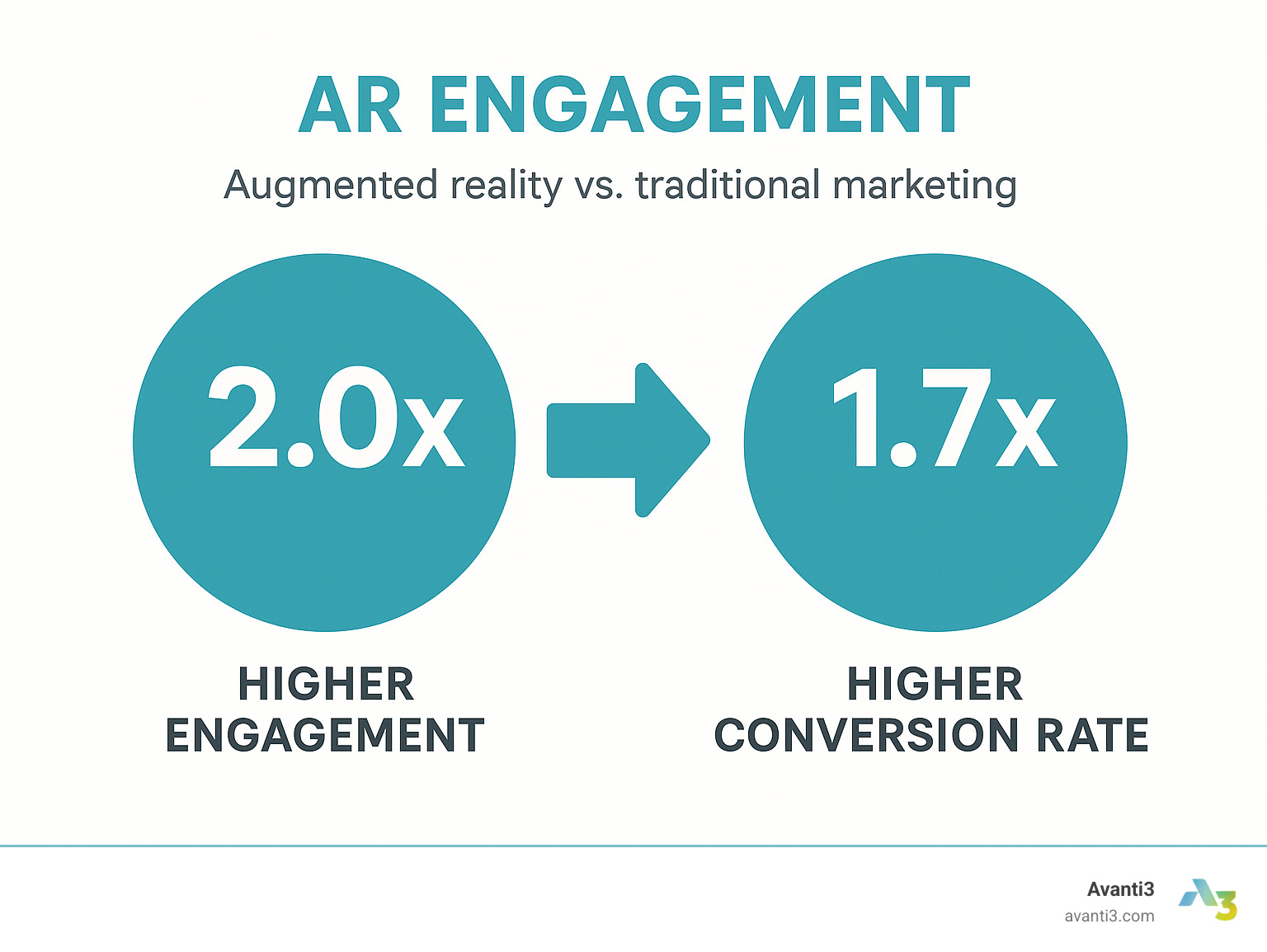
Conclusion & Next Steps
As we’ve seen throughout this guide, augmented reality engagement has transformed from an interesting tech novelty into an essential component of modern marketing. What makes AR so powerful is how it creates meaningful connections at every stage of the customer journey.
Think about it: AR helps customers visualize products in their homes before buying, removes purchase uncertainty at the point of sale, and continues delivering value long after purchase through interactive support. The numbers speak volumes—200% higher engagement, conversion rates jumping by up to 94%, and brand loyalty increasing by 64%. But perhaps the most valuable aspect is how AR creates genuine emotional connections between people and brands.
The Future of AR Engagement
The AR landscape is evolving rapidly, and several exciting trends are shaping its future:
The rise of AR glasses and wearables will free us from the constraints of smartphones, creating more natural, hands-free interactions. Imagine walking down a store aisle and seeing personalized product information appear before your eyes without even reaching for your phone.
AI and AR are becoming powerful partners. This fusion will enable experiences that adapt in real-time to your personal preferences, past behaviors, and even current emotional state. Your AR shopping experience might look completely different from someone else’s—custom specifically to you.
AR is also becoming increasingly social, building communities through shared experiences. Rather than interacting with AR alone, you’ll be able to share these moments with friends and family, adding a whole new dimension to brand communities and shopping experiences.
The boundaries between digital and physical will continue to blur until AR becomes an expected part of everyday life. Soon, we’ll look back and wonder how we ever shopped without these augmented layers of information and interaction.
Taking the First Step
Ready to explore how augmented reality engagement could transform your customer relationships? Here’s a straightforward path to get started:
First, identify specific opportunities in your customer journey where AR could solve real problems or improve experiences. Look for pain points or moments where traditional approaches fall short.
Start small with a focused pilot project. Choose something with clear objectives that addresses a specific business goal—whether that’s increasing product visualization before purchase or improving self-service support.
Measure your results carefully. Establish clear KPIs from the beginning so you can track exactly how your AR initiatives are performing and demonstrate their value to stakeholders.
Finally, use what you learn to refine and expand your approach. The first iteration is rarely perfect, but each cycle of feedback and improvement will strengthen your AR strategy.
With 1.73 billion AR-capable devices expected by the end of 2024, the question isn’t whether to adopt AR, but how quickly you can leverage it to create meaningful advantages for your business and customers.
At Avanti3, we’re passionate about helping businesses integrate technologies like AR into cohesive engagement strategies. Our approach combines Web3 technologies—NFTs, blockchain, AR/VR, and AI—to create customizable engagement tools that build deeper connections between brands and their audiences.
For businesses looking to create stronger communities through immersive technologies, more info about community building platforms can provide additional insights and strategies.
The most successful AR implementations aren’t about showcasing flashy technology—they’re about creating meaningful, memorable moments that resonate with people. By focusing on delivering genuine value rather than novelty, your brand can harness the true power of augmented reality engagement to transform customer relationships and achieve measurable business results that last.


